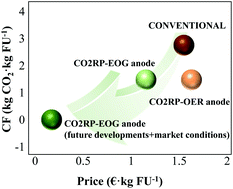Feasibility analysis of a CO2 recycling plant for the decarbonization of formate and dihydroxyacetone production†
Abstract
Renewable-driven CO2 recycling plants (CO2RPs) to produce chemicals have a certain role to play in the decarbonization of the economy. In recent years, significant progress has been made in the decarbonization of chemicals such as formate/formic acid (HCOO−/HCOOH) by CO2 electrochemical reduction (CO2ER). The traditional approach consists of the cathodic CO2ER coupled to the anodic oxygen evolution reaction (OER). Current trends consist of alternative anodic processes, such as glycerol (GLY) electro-oxidation (EOG), as a powerful alternative to the OER because it can noticeably lower the cell voltage. Also, this recent alternative leads to the formation of products in the anode with more economic value than O2, for example, the fine chemical dihydroxyacetone (DHA). Until now factors other than just the energy savings in the ER cell have been neglected. But these factors, such as the anodic market size, the downstream separation energy demand, etc., have to be contemplated in the whole decarbonization picture. In the present study, we analyze the environmental and economic benefits of the integrated production of HCOO− and DHA by a renewable-driven CO2RP in which the traditional OER is substituted by the EOG alternative. Life Cycle Thinking was used to support the decision-making. HCOO− and DHA fossil routes as well as the traditional decarbonization OER scheme (that decarbonized the amount of HCOO−) were used for benchmarking. The integrated production in the proposed CO2RP is highly limited by the small market size of DHA compared to that of HCOO− and also by the high energy requirements in the DHA purification step. Anodic DHA concentration over 1.5 wt% is compulsory in short–mid-term developments to achieve a positive decarbonization scenario wherein the integrated production of DHA and HCOO− is compared with the traditional route. A noticeable reduction in the market price of DHA would be possible with appropriate anode developments. In addition, we evaluate the influence of the renewable electricity market forecast in the economic figures of DHA and HCOO− produced by the co-electrolysis technology.



 Please wait while we load your content...
Please wait while we load your content...